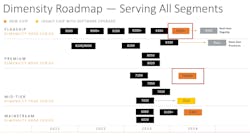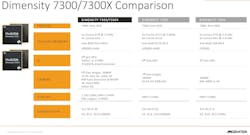What you’ll learn:
- The Dimensity 9300+’s large-language-model (LLM) capability.
- New chips in the Dimensity product family.
The Dimensity 9300+ platform developed by MediaTek builds on the artificial intelligence/machine learning (AI/ML) of the Dimensity 9300 while including features like ray-tracing support from the earlier Dimensity 9200. I talked with Finbarr Moynihan, MediaTek’s Vice President of Corporate Marketing, about the company’s latest chip (see the video above).
The same third-generation, TSMC 4-nm (N4P) process is utilized with the Dimensity 9300+ (Fig. 1). The new generative AI hardware acceleration can handle up to 7 billion parameters, putting it on the edge for mobile devices like high-end smartphones. It can process 22 tokens/s and includes support for speculative decode and ZipLoRA. It also supports Google’s DeepMind Gemini Nano and Meta’s Llama2 ExecuTorch.
The Dimensity 9300 family LLM support enables applications like the VIVO X100 Pro and Real-time Assistant for the Visually Impaired to run on mobile devices (Fig. 2). LLMs help deliver features like text-to-image, -speech, and -music as well as image-to-image transformations for photo editing and video streaming.
The main Arm Cortex-X4 in the Dimensity 9300+’s octal core has been bumped up to 3.4 GHz while the remaining Cortex-X4 and Cortex-A720 cores operate at the same frequency as the Dimensity 9300. The Dimensity 9300+ is at the top of MediaTek’s food chain (Fig. 3), which also includes new 7300 and 6300 chips.
The 7300 is also based on the 4NP process. Its octal processing system uses four 2.5-GHz Arm Cortex-A78 cores and four Cortex-A55 cores (Fig. 4). The GPU is an Arm Mali G615 MC2. AI/ML acceleration is provided by a sixth-generation APU. This midrange mobile platform supports 2x2 Wi-Fi 6E along with 5G support. The 7300X target flip phones that support a 120-MHz, 1.5K retina (1300 × 2760 pixels) display.




